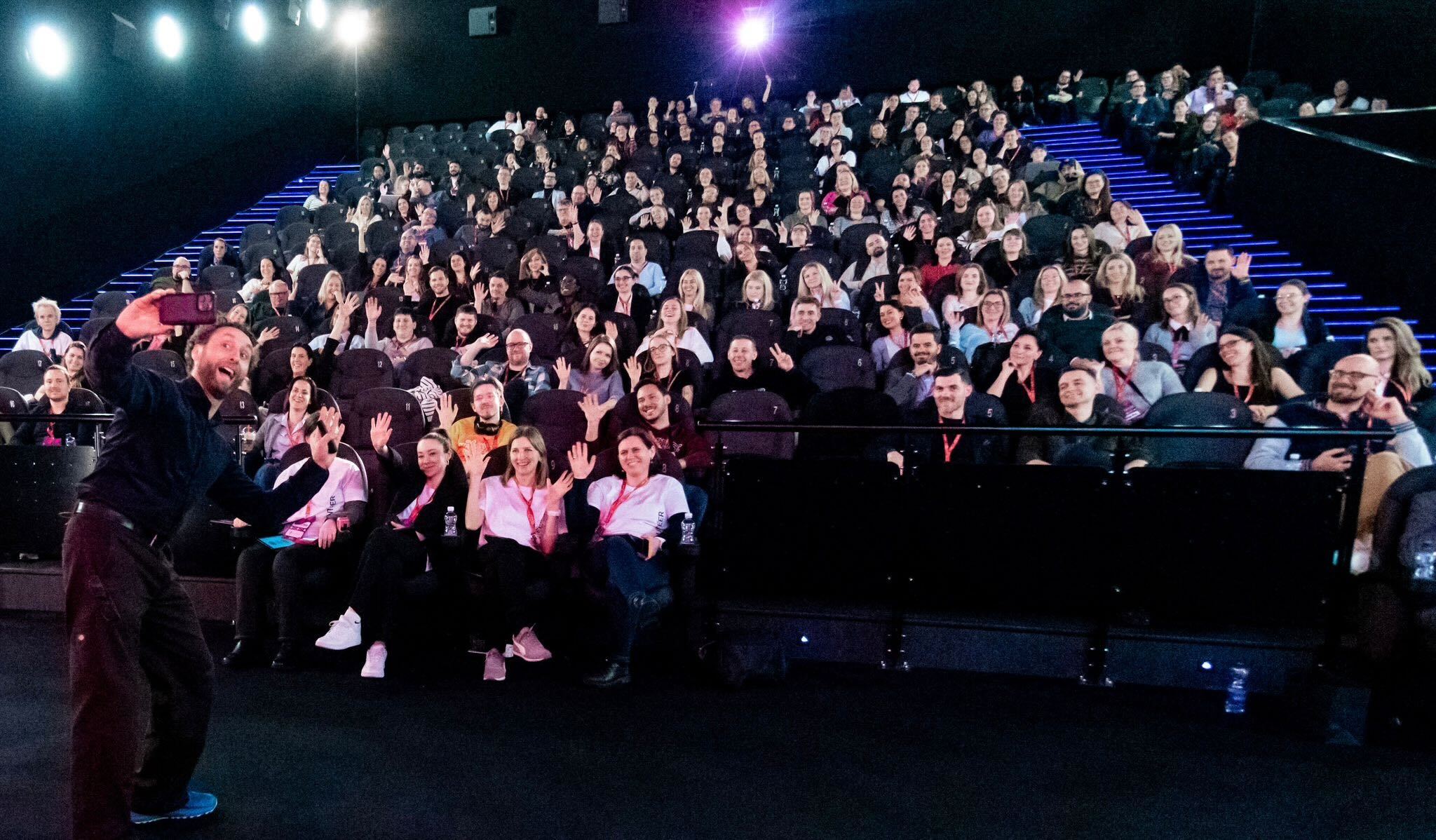
So, you’ve found yourself in the precarious position of standing in front of a bunch of strangers, with a mic attached to your chest, and all eyes fixed on you. Whether you’re here because your boss said so, or because you’re on a mission to conquer the marketing world as a presenter one PowerPoint at a time, or maybe you just want to share your wisdom – fear not, for I’ve been there, done that, and got the literal t-shirt.
After 15 years of presenting across the globe, I’ve seen the good, the bad, and the cringe-worthy, so I’m here to share my tips on how to become a presentation expert.
The mighty sound guy
Let’s start with a shout-out to the unsung hero of every presentation – the “sound guy”. This person is non-gender specific, it’s just a great label and holds the power to make or break your moment in the spotlight.
My basic theory is that the most important person in the room is the sound guy. After one of my events, I went to get my laptop, and they told me, “Hey, I liked your talk, it was the best of the day.” This made me think that this happens a lot. So, unless sound deck people are just eager for the visiting speakers to be happy that they tell every one of them they are the best… it might be something that I’m doing right.
But why prioritise their opinion? They aren’t subject matter experts, after all.
That’s precisely my point. Despite lacking specialised knowledge, the sound guy represents the average audience member – intelligent but not versed in the minutiae of your content. Their endorsement carries weight, indicative of how your message resonates with the broader audience.
Another telling sign of a successful talk is when you look out into the audience and see numerous phones held up, ready to capture the moment. This makes it clear that what you’re saying resonates with them in a meaningful way.
So, how do we totally nail being totally amazing? Let’s break this down into four simple areas:
1. Know your audience
Topic: Understanding the theme or purpose of the event is crucial. Just as there are countless flavours of ice cream, conferences come in a myriad of flavours too. So, it’s essential to align your talk with the overarching theme of the event. Try engaging in a conversation with the event organisers beforehand as they can provide invaluable insights into the attendees’ interests and expectations.
Seniority: Think about the level of expertise and familiarity your audience has with the subject matter. Whether you’re speaking to a room of seasoned professionals or a group of newcomers, tailoring your content to their knowledge level ensures that you strike the right chord and keep everyone engaged.
2. Structure your content
The opening: Everyone loves a good story. Starting your presentation with a captivating anecdote or intriguing fact sets the stage for an engaging journey ahead and gives the audience a sneak peek at what they are in for.
The deal: Strike a deal with your audience. Think of it as a verbal handshake, where you pledge to deliver valuable insights, answers to burning questions, or actionable takeaways that they can apply immediately. It’s about setting clear expectations right from the start and then fulfilling them throughout your presentation. When you strike this deal, you’re essentially telling your audience, “I respect your time, and I’m committed to making it worth your while.”
Signpost: You can never explain enough where you have got to and where you are going next. Guide your audience through your presentation by clearly indicating your progress and what’s coming next. Regularly remind them of the structure to maintain clarity, every five minutes or so should do the trick.
Blend theory and practical tips: The theories give you the recipe, while the practical tips are the special ingredients that make it truly worthwhile. It’s all about giving your audience knowledge they can use in their everyday lives. At some point in every section, the audience should resist the urge to take a pic of the screen because it has some killer takeaways on it. In one of my most popular talks I spend 10 minutes looking at the psychology of why video works, but then give practical models that people can use to plan content … this balance works really well. Steal my approach here.
Mix up the media: Using different media formats, such as videos or visuals, adds layers of depth and interest to your talk. Don’t be afraid to show videos of other experts talking about things. You can let them speak for themselves and then your presentation can be more like a documentary than a standard talk.
Less is more: You can make your audience feel anything but confused. Once people are confused you’ve lost them. When you are getting your content together, if what you are saying is too complex, don’t just hope they will get it. In a world inundated with information, simplicity is key. Strip away the unnecessary details, focus on the core message, and deliver it with clarity and impact. It’s about cutting through the noise and ensuring that your message shines through crystal clear.
Dress appropriately: Before stepping on stage take a moment to ensure that your attire is not only professional but also comfortable. Check that your microphone is discreetly positioned and your appearance exudes confidence. After all, first impressions matter, and you want to convey credibility from the beginning. I’ve watched videos before and been horrified to see my shirt doing odd things and the microphone poking out where it shouldn’t.
Use slides as prompts: I don’t script, but to save myself having to fully learn what I’m saying I use the slides as a prompt for what I’m saying, without overdoing the amount of copy. Slides should complement your presentation, not overshadow it. They serve as visual aids to prompt your discussion points, providing a roadmap for both you and your audience. Think of them as your trusty sidekick, guiding you through the narrative.

Avoid self-promotion: As a presenter don’t promote yourself and think that people are there to hear about you, they are not, and everyone hates it. The number one thing people do not want at a conference is being told how great you are and what amazing work you’ve done. While it’s essential to showcase your expertise, humility goes a long way. Instead of drowning your audience in a sea of self-praise, let your content speak for itself. Give yourself three slides max and power through them. Have a QR code or link on the screen for those who want to know more.
A pet peeve of mine is when speakers attempt to “humanise” themselves by showcasing their endeavours, such as ultra-marathon running or exotic diving trips, during a presentation. If you have a limited time slot, like 20 minutes on stage, dedicating two minutes to such anecdotes can be counterproductive. Attendees are primarily there to absorb valuable insights rather than your dating profile. Therefore, it’s best to jump straight into the content without unnecessary detours.
3. Style
Find your style, but observe others: There is a book called “Talk Like TED” which reviews numerous TED talks to see what works.
Tone: Speak in a lower register. There’s a temptation to speak loudly or shout, thinking it helps you be heard. However, with a microphone, this can come off as slightly aggressive. There’s also a tendency to speak in a higher vocal range than usual, which can make you sound nervous and unsure. Lower your tone, imagine chatting with someone nearby, rather than projecting to the back of the room.
Vary your pitch: Avoid speaking in a monotone voice. Instead, vary your pitch. Slow down in some parts, speed up in others, and allow pauses for the audience to laugh or absorb information.
Using your clicker: It’s common to see presenters point their clicker at the screen, but this isn’t necessary and can appear awkward. Keep the clicker in your hand by your side or wherever it’s comfortable, and use it naturally as part of your conversation.
Be relatable: Imagine you’re speaking to a small group of friends. Being human and approachable makes your audience feel more connected to you as a presenter. Add in a little humour. No matter the topic, it can work wonders. Find a light-hearted joke or line that resonates with your audience and stick to it. A small chuckle can relax the room and make them more receptive to your message. Now I’m not saying you have to be the next Frankie Boyle but a little humour can enhance your message by making it memorable (Forbes, 2023).
Gaze around the room, engaging different corners as you talk and resist the urge to remain fixated on the screen. While old-school advice tells you to stare into people’s eyes, I’ve found that a subtle glance in their direction is less awkward and more effective.
And if you can swing it, always insist on having a preview monitor. Relying solely on the screen behind can sometimes be asking for trouble.

4. Keep improving
To keep improving as a presenter, you must watch recordings of yourself no matter how painful. Take note of what went well and where you can tweak things a bit. And don’t be shy about asking for feedback—it’s how we all learn and grow.
Author & Expert Presenter for Video, Marketing & Social Media Events.
Hurricane’s Managing Director Jon Mowat has built a solid reputation as an engaging keynote speaker and host at marketing and industry-specific events in 6 countries. He consistently scores the highest levels of feedback at events he attends, and gives events the high-quality content that delegates love.
Building on insights from his 20 years of experience and honed from his two books on video marketing, Jon brings theory to life with engaging examples and practical exercises.
Jon entertains audiences with an energetic, captivating presentation style. He adapts his content to fit specific audiences and regularly works with marketing directors, brand leaders, social media professionals, internal brand teams and marketing students.


